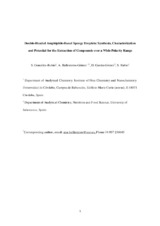Mostrar el registro sencillo del ítem
Double-headed amphiphile-based sponge droplets: synthesis, characterization and potential for the extraction of compounds over a wide polarity range
| dc.contributor.author | González Rubio, S. | |
| dc.contributor.author | Ballesteros-Gómez, A. | |
| dc.contributor.author | García-Gómez, D. | |
| dc.contributor.author | Rubio Bravo, Soledad | |
| dc.date.accessioned | 2024-01-08T11:17:00Z | |
| dc.date.available | 2024-01-08T11:17:00Z | |
| dc.date.issued | 2022 | |
| dc.identifier.uri | http://hdl.handle.net/10396/26445 | |
| dc.description.abstract | Supramolecular solvents (SUPRASs) are gaining momentum in the multi-residue analysis of liquid samples thanks to the delimited hydrophilic and hydrophobic microenvironments in their nanostructures. In this work, SUPRASs with increased hydrophilicity were synthesized with the aim of enhancing the extractability of polar compounds. For this purpose, a double-headed amphiphile, 1,2-decanediol, was self-assembled in hydro-organic media in the presence and absence of sodium chloride. The SUPRASs formed, characterized by scanning electron microscopy, consisted of sponge droplets made up of a highly convoluted three-dimensional (3D) network of amphiphile. The network contained interconnected bilayers that were intersected by similarly interconnected aqueous channels with high and nearly constant water content (∼30%, w/w). Both the inherently open structure of the sponge morphology and the increased hydrophilic-hydrophobic balance of the amphiphile, provided highly hydrophilic microenvironments into the aggregates that rendered in increased recovery factors for 15 perfluorinated compounds (PFCs, C4–C18, log Pow values from 0.4 to 11.6) in natural waters. Extraction took 15 min without further clean-up or evaporation of extracts which were readily compatible with LC-MS/MS quantitation. Absolute recoveries for PFCs, at the level of a few ng L−1, were in the range 70–120%, except for perfluoropentanoic acid (40%) and perfluorobutane sulfonic acid (51%). Detection limits for PFCs in water were in the range 0.01–0.02 ng L−1, which allowed their determination in slightly polluted waters (0.07–2.33 ng L−1). This work proves that hydrophilicity in SUPRASs can be tailored through the amphiphile and the morphology of their aggregates, and that this characteristic improves compound extractability in multi-residue analysis. | es_ES |
| dc.format.mimetype | application/pdf | es_ES |
| dc.language.iso | eng | es_ES |
| dc.publisher | Elsevier | es_ES |
| dc.rights | https://creativecommons.org/licenses/by-nc-nd/4.0/ | es_ES |
| dc.source | González-Rubio, S., Ballesteros‐Gómez, A., García-Gómez, D., & Rubio, S. (2022). Double-headed amphiphile-based sponge droplets: synthesis, characterization and potential for the extraction of compounds over a wide polarity range. Talanta, 239, 123108. https://doi.org/10.1016/j.talanta.2021.123108 | es_ES |
| dc.subject | Supramolecular solvent (SUPRAS) | es_ES |
| dc.subject | Sponge phases | es_ES |
| dc.subject | Double-headed amphiphile | es_ES |
| dc.subject | Liquid-liquid extraction | es_ES |
| dc.subject | Liquid chromatography-mass spectrometry | es_ES |
| dc.subject | Perfluorinated compounds | es_ES |
| dc.title | Double-headed amphiphile-based sponge droplets: synthesis, characterization and potential for the extraction of compounds over a wide polarity range | es_ES |
| dc.type | info:eu-repo/semantics/article | es_ES |
| dc.relation.publisherversion | https://doi.org/10.1016/j.talanta.2021.123108 | es_ES |
| dc.relation.projectID | Gobierno de España. CTQ2017-83823 R | es_ES |
| dc.relation.projectID | Gobierno de España. RYC-2015-18482 | es_ES |
| dc.rights.accessRights | info:eu-repo/semantics/openAccess | es_ES |

